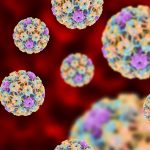Pediatric Probiotics: Impact on the Development of a Normal Immune System
Mary Grabowska, ND, LM, LAc and Mairi R. Ross
Probiotics are familiar to most naturopathic physicians in their pediatric practice as a way of supporting the restoration of natural flora during and after antibiotic use. As a naturopathic midwife, I use probiotics in the following areas:
- Intermittently throughout pregnancy when clinically indicated (e.g., candidal vaginitis, bacterial vaginosis, group B strep positive mom, after antibiotic use)
- Continuously in the last 2 months of pregnancy in moms with atopic family history
- Newborn thrush, candidal diaper rash, colic
- Gastroenteritis
- General immune support during illness (cold, URI, sinusitis).
Probiotics are defined as “live microorganisms which, when administered in adequate amounts, confer a health benefit on the host” (FAO/WHO, 2001). Adult humans are colonized with more than 500 strains of bacteria. Infants, however, are born with a sterile gut. They begin to acquire their good bacteria as they come down the vaginal canal and into contact with skin and their environment. Children will continue to adopt bacteria for colonization until about the age of two. After that, the individual’s colony of bacteria will stay stable throughout their life unless disrupted by environmental factors.
It is estimated that antibiotics may disrupt the normal colony for up to three months (De la Cochetiere, 2004), requiring probiotic supplementation during and after that period. Further research may indicate even more serious disruption, especially after a series of antibiotics. All probiotic supplementation is essentially temporary. Some strains will colonize for a few days and some up to a year or more. So-called “transient” strains transit faster than “adhering” strains, but no probiotic strains colonize permanently after the age of two.
Probiotic Research
Although we, as naturopathic physicians, are often ahead of the clinical curve, there is a growing body of clinical research that supports use of probiotics in the following areas:
- Diarrhea: Rotavirus, bacterial and antibiotic-associated. Daily use of rhamnosus, L. reuteri, L. casei, S. boulardii and B. lactis has been shown to reduce the duration of rotavirus or other GI pathogens in children and adults (Reid, 2006; Van Niel, 2002). Probiotics are being used successfully to reduce the incidence of antibiotic-associated diarrhea (Correa, 2005; Szajewska, 2006). Clostridium difficile infection in children (usually following antibiotic use) has been reduced with S. boulardii (Kotowska, 2005).
- Atopic eczema and allergy. This research by a Finnish team was a landmark study for the use of probiotics to reduce allergic diseases and their effect on the immune system of infants. rhamnosus (GG) was administered to pregnant women at high risk for allergic disease in the last trimester and to nursing mothers, or given in formula to infants. The incidence of atopic eczema dropped by 50% in the probiotic group. This result continued into the fourth year, although no further probiotics were administered (Kalliomaki, 2003). A recent Australian study showed probiotics alleviated extent and severity of atopic dermatitis in young children. L. reuteri (previously categorized as fermentum) was given daily for eight weeks. Improvement in the probiotic group was 92%, versus 63% improvement in the placebo group. Dosage was 1 billion cfu of freeze-dried powder twice daily for eight weeks (Weston, 2005).
- Inflammatory bowel diseases and pouchitis. Pediatric data is limited for inflammatory bowel diseases (Gupta, 2000), though some adult studies show promise on ulcerative colitis and pouchitis (Schultz, 2003). The use of a highly concentrated probiotic preparation (900 billion bacteria daily in two divided doses) for one year has been effective in adult pouchitis (Gionchett, 2003). Clinical trials have seen little success with the treatment of Crohn’s disease, however. Two strains – rhamnosus GG and L. johnsonii La1 – have not shown benefit. It is possible that other strains or combinations of strains would be effective.
- Irritable bowel syndrome (IBS). Gregor Reid, Ph.D., a leading probiotic researcher, comments that, “the multidimensional nature of IBS makes it difficult for a single probiotic product to provide widespread efficacy.” Promising results have been seen for pain, discomfort and bloating with infantis (1X10(10) live bacterial cells) (Reid, 2006).
- Sinus and ear infections. The nasal cavities are a reservoir for aureus and other potentially pathogenic bacteria (PPB) in up to 70% of the adult population. These nasal bacteria can cause ear, lung and sinus infections, as well as infect head wounds and surgical wounds. An oral multi-strain probiotic formula with 45.7 billion CFUs per serving significantly reduced presence of PPBs in the nasal cavities. It’s possible that reducing the presence of PPBs in the nasal cavities would reduce incidence of ear and sinus infections (Gluck, 2003).
- Illness of infants in day care centers. As most parents realize, children who attend day care seem to be ill more frequently – as are their parents! This randomized, double-blind, placebo-controlled study investigated the occurrence of infections in 201 healthy infants ages 4-10 months during a period of 12 weeks in day care. Two probiotics were studied: reuteri and B. lactis Bb-12. Both probiotic groups resulted in significantly fewer infections as measured by fever and gastrointestinal infection. The effects were more prominent with L. reuteri (Weizman, 2005).
- Common cold and upper respiratory tract infections. The intake of probiotic bacteria gasseri, B. longum and B. bifidum (5X10(7) CFU/tablet) over a period of three months by adults significantly shortened common cold episodes by almost two days and reduced the severity of symptoms (deVrese, 2005). Daily consumption of milk containing L. rhamnosus GG by healthy children resulted in a 17% relative reduction in the number of children suffering from respiratory infections. The mechanisms of how probiotics affect sites away from the intestinal tract are believed to be the enhancement of mucosal immunity (Hatakka, 2001).
- Dental caries. The same children studied in the Hatakka study were found to have a significantly reduced risk of caries as measured by mutans streptococci levels in dental plaque and saliva (Nase, 2001).
- Candida albicans. Diaper rash and thrush are two indications of common Candida albicans overgrowth. Candida is also a serious problem in premature infants. Research on very low birth-weight infants indicates that probiotics can help reduce Candida in infants (Manzoni, 2006).
- Urinary infections. Using probiotics to maintain a healthy balance of microflora in the bowel and rectal area in pediatric patients helps to reduce the incidence of recurring urinary infections (Gerasimov, 2004).
- Continual crying was reduced by the use of an L. reuteri probiotic (Savino, 2005).
- Lactose intolerance. The lactic acid bacteria, especially yogurt starter cultures Lactobacillus bulgaricus and Streptococcus thermophilus, digest lactose before it reaches the colon and improve digestion of lactose (www.usprobiotics.org).
- Necrotizing enterocolitis (NEC). Very low birth-weight infants have a low colonization of Bifidobacteria and Lactobacilli, which provide a natural defense against pathogenic bacterial infections. These infections can result in life-threatening infections of necrotizing enterocolitis. High-potentcy probiotics containing acidophilus and B. infantis given to very low birth-weight infants significantly decreased the incidence and severity of NEC (Lin, 2005; Bin-Nun, 2005).
Pregnancy, Birth and Probiotics – The Immune Connection
I have been especially interested in probiotic research that reveals the importance of colonization of natural microflora at birth and its impact on the development of a normal immune system. The rise in C-sections to 30% in the U.S. combined with low levels of natural flora in mothers, low rates of breast feeding and sterile hospital environments all have a negative effect on the normal microflora colonization of the infant. It’s also important to note that “no indicated risk” first-time Caesarean rates increased by 67% from 1991 to 2001 (BMJ, 2004).
Research indicates that these weaknesses in normal colonization may lead to suboptimal immune development, resulting in increases in allergic diseases and gastrointestinal problems. One study concluded that the type of bacteria colonizing the intestine of the newborn and the timing of that colonization is critical to healthy immune development (Gronlund, 2000). We are all aware of the dramatic rise of pediatric allergies, eczema, asthma and gastrointestinal problems such as IBS and IBD. Having a disrupted microflora is implicated. Disrupted microflora has also been shown to exist in many autistic children. It’s possible that the administration of probiotics to pregnant women and infants, especially those delivered by C-section, pre-term and formula fed, might help fill the current gaps in natural microflora colonization.
I and other members of the American Association of Naturopathic Midwives routinely prescribe probiotics to pregnant women and newborns, especially those born via C-section. Administration of an infant probiotic on Day 1 is preferable. Days 1 to 3 seem to be a critical immune development window for microflora impact on the immune system. It will be no surprise to naturopathic physicians that full-term infants born vaginally at home and breastfed exclusively have the most beneficial gut microbiota, with the highest numbers of bifidobacteria and the lowest numbers of C. difficile and E. coli (Penders, 2006). Infants delivered by C-section have a different balance of bacteria from vaginally delivered infants, delayed colonization and an earlier acquisition of bacteria such as C. difficile from the environment. C-section has recently been implicated as a risk factor for diarrhea and sensitization to nutritional allergens in parents with a history of allergy (Laubereau, 2004; Negele, 2004).
Declining Microflora
The most recent research, however, indicates that “traditional” fecal bacteria in all hospital-born infants, not just C-section delivered infants, is declining in industrialized countries (Adlerberth, 2006). The traditional first colonizers have been enterobacteria. A Swedish study found that the first colonizers were now coagulase-negative staphylococci, which colonized 99% of the infants studied from Day 3 onward. It took up to two months for all infants to be colonized by enterobacteria. Bacteroides, an important traditional early colonizer, initially colonized only 30% of vaginally delivered infants and increased very slowly in prevalence. Bacteroides colonization was delayed up to a year in C-section-delivered babies.
So, we know that modern lifestyle and healthcare factors are drastically changing the colonization of infants. Why does that matter? And how could probiotics help?
Why Microflora Matter
We know that the two main roles of colonization of intestinal microflora are extremely important, even though the mechanisms are still not fully understood. Because more than 70% of all immune cells are represented in the epithelial lining of the small intestine, the first role of natural microflora is to promote a healthy immune development. Natural microflora stimulate the local innate immune response, resulting in an optimal innate-adaptive immune interface. This interface promotes balanced Th1 and Th2 adaptive responses, which promotes antigen oral tolerance. Parallel with this, natural microflora creates a barrier to pathogenic bacterial colonization. The second role is participation by the microflora in dietary metabolism. Microflora improve dietary tolerance (Langhendries, 2005).
Prolonged breastfeeding, which supplies both microflora and a soluble fiber that supports growth of microflora in the large intestine, is nature’s best way to induce both optimal immune function and optimal metabolic activity (Orrhage, 1999).
The best way to encourage favorable bacterial colonization of the newborn’s intestine would be to avoid any alteration of the mother’s recto-vaginal microflora. It is the most important determinant of neonatal colonization. Broad-spectrum antibiotics given to the mother while she is pregnant will modify her microflora and reduce the infant’s optimal colonization (Langhendries, 1999).
Probiotics – Before Birth and Beyond?
Based on research to date and my experience, it appears that it is possible to support normal flora in the mother with a probiotic and positively affect the infant’s colonization (Isolauri, 2004, 2001).
It may also be possible to affect the infant’s colonization with a probiotic supplement. Traditionally, normal colonization of infants favored a high level of bifidobacteria. Viable bifidobacteria given to neonates seem to be able to induce bifidobacterial prevalence at one month of age, close to that of breast-fed infants (Langhendries, 1995). Another study demonstrated that giving a mother a mixture of lactobacilli and bifidobacteria before delivery and continuing to administer to the infant may influence gut immunity (Rinne, 2005).
Given the importance of the natural microflora and its assault by our modern healthcare and lifestyles, it might be time to consider daily probiotic supplementation for infants and toddlers, especially those who have taken antibiotics, are premature, delivered by C-section or formula fed.
Strain Selection
It is important to note that effectiveness of one strain does not imply the same effectiveness with other strains. For example, lactobacilli strains primarily impact the small intestine, while bifidobacteria strains are effective in the large intestine. One small review of studies indicates that multi-strain formulas are more effective than single-strain formulas (Timmerman, 2004). Common sense leans towards the use of multi-strain formulas, as they more closely replicate the wide variety of bacteria in the normal human gut. However, clinical studies will usually lean towards research with a single strain, as it presents fewer variables. Research also tends to cluster around strains with the most support from the manufacturer of the strain. It’s best to use an age-specific formula for children younger than 2 that includes a predominance of bifidobacteria. Children older than 2 can use an infant or adult formula.
Preferred strains for mothers and infants based on current research:
- Bifidobacterium infantis (e.g., Bi-07)
- Bifidobacterium bifidum
- Bifidobacterium breve
- Bifidobacterium longum
- Bifidobacterium lactis (e.g., Bb12)
- Lactobacillus rhamnosus (most research done with GG)
- Lactobacillus acidophilus
- Lactobacillus paracasei
- Lactobacillus reuteri (fermentum)
- Saccharomyces boulardii.
Prebiotics
Prebiotics are non-digestible substances that provide a beneficial effect on the host by stimulating growth and/or activity of beneficial microflora (Gibson, 1995).
Dietary sources
- Breast milk
- Jerusalem artichoke
- Onions
- Garlic
- Bananas
- Chicory
- Honey (not for children younger than 1 year).
Prebiotic supplements
- Fructooligosaccharide (FOS)
- Other oligosaccharides
- Inulin
Dosages
Patrick Hanaway, MD, in an excellent article on microflora and the immune system in Alternative Therapies (Sept/Oct 2006), references a dose response study on childhood diarrhea published in the British Medical Journal (Hatakka, 2001) that correlates a reduction in diarrheal days with dosages above 10 billion cfu and up to 150 billion cfu per day. There are, however, few dose response studies on probiotics. Because probiotic dose-response studies are rare to non-existent, the practitioner must use several avenues of input to determine dosages. Fortunately, probiotics are safe, and toxicity is not an issue (Cabana, 2006). It’s wise to consider dosages used in clinical studies, manufacturers’ recommendations, intuition and common sense, as well as consider input from other practitioners on what has been effective in their practices. I use the following dosages as a baseline:
During and after antibiotic use:
- Pregnant mothers: 1 capsule qd ~15 billion CFU
- Infants: Small dose; usually 1/16tsp bid; more if not breast fed. More can lead to excessive fermentation, bloating and GI distress.
- Children: 5 billion CFUs/day, 1/4tsp bid with food
- Diarrhea: 1 capsule bid
- Daily probiotics while in day care/school: ½tsp qd
- Atopic eczema: ¼tsp bid
- Newborn after C-section: 1/16tsp bid.
Case Study #1
A 36-year-old primiparous mother presents at her two-week postpartum visit complaining of persistently sore nipples. Upon exam, her nipples reveal shiny, erythematous lesions on her areola. A quick exam of the infant’s mouth shows a slight white coat to the tongue and a red, bumpy perianal rash with satellite lesions. A paste of infant multistrain probiotic and water is recommended to the mom. She applies the bifidus topically to her nipples three times daily after nursing. She also swabs the baby’s mouth with the same preparation three times daily. Within three days, the chief complaint of nipple pain is completely resolved. Additionally, the newborn’s tongue is a beautiful pink with no coat and the perianal rash is gone. The mother reports the baby to be noticeably more content.
Case Study #2
A 34-year-old female presents at 20 weeks gestation with a history of mild to moderate asthma and multiple allergies to both foods and medications. Her diet is exceptional – organic, whole foods, gluten free – but she is experiencing candidal vaginitis. A multistrain probiotic is prescribed both orally and vaginally. The vaginitis clears quickly and paves the way for a discussion about the benefits of probiotics in pregnancy, especially to the newborn. The patient excitedly agrees to take a probiotic containing Bifidobacteria longum and Lactobacillus rhamnosus for the last trimester. Additionally, after her vaginal homebirth, she begins supplementing the baby directly with the addition of Bifidobacteria infantis. The mother remarks at the six-week visit that this baby, her second, seems much healthier, no skin rashes, more comfortable intestinally, bowel movements more regular and the consistency of the stool less changeable. At the six-month visit, she reports no URIs, ear infections or any illnesses, despite her preschooler coming home with multiple URIs.
Shortly thereafter, the 8-month-old patient returns sporting a well-circumscribed rash on her torso and axilla. Her mother reports taking her to the conventional pediatrician who wasn’t sure if the rash was eczema or candida, and so prescribed a topical steroid and antifungal combination. The rash was markedly worse two days later. I explained that steroids are immune suppressants and remark that the rash is definitely candida. Probiotics are resumed, homeopathic calcarea carbonica 200c (single dose) given, as well as a calendula wash prescribed. Within ½ day, the rash is markedly less erythematous. The rash disappears entirely in three days, and at 2½ years of age, the child has experienced no other illnesses.
References
De la Cochetiere et al: Early intestinal bacterial colonization and necrotizing enterocolitis in premature infants: the putative role of Clostridium, Pediatr Res Sep;56(3):366-70, 2004.
Reid G. The effects of oral probiotics on the treatment of intestinal and distant site ailments, U.S. Gastroenterology Review, 2006
Van Niel et al: Lactobacillus therapy for acute infectious diarrhea in children: a meta-analysis, Pediatrics 109:678-684, 2002.
Correa NM et al: A randomized formula controlled trial of Bifidobacterium lactis and Streptococcus thermophilus for prevention of antibiotic-associated diarrhea in infants, J Clin Gastroenterol 39(5):385-389, 2005.
Szajewska H et al: Probiotics in the prevention of antibiotic-assoicated diarrhea in children: a meta-analysis of randomized controlled trials, J Pediatr Sep;149(3):367-372, 2006.
Kotowska M et al: Saccharomyces boulardii in the prevention of antibiotic-associated diarrhea in children: a randomized double-blind placebo-controlled trial, Aliment. Pharmacol. Ther. 21:583-590, 2005.
Kalliomaki M et al: Probiotics and prevention of atopic disease: 4-year follow up of randomized placebo-controlled trial, Lancet 361:1869-1871, 2003.
Weston S, et al: Effects of probiotics on atopic dermatitis: a randomized controlled trial, Arch Dis Child 90:892-897, 2005.
Gupta P et al: Is lactobacillus GG helpful in children with Crohn’s disease? Results of a preliminary open-label study, J Pediatr Gastroenterol Nutr 31:453-457, 2000.
Schultz M et al: Rationale for probiotic and antibiotic treatment strategies in inflammatory bowel diseases, Dig Dis 21:105-128, 2003.
Gionchetti P et al: Prophylaxis of pouchitis onset with probiotic therapy: a double-blind, placebo-controlled trial, Gastroenterology 124:1202-1209, 2003.
Reid G: The effects of oral probiotics on the treatment of intestinal and distant site ailments, U.S. Gastroenterology Review, 2006.
Gluck U and Gebbers JO: Ingested probiotics reduce nasal colonization with pathogenic bacteria – Staphylococcus aureus, Streptococcus pneumoniae, and beta-hemolytic streptococci, Am J Clin Nutr 77:517-520, 2003.
Weizman Z et al: Effect of a probiotic infant formula on infections in child care centers: comparison of two probiotic agents, Pediatrics 115:5-9, 2005.
de Vrese M et al: Effect of L. gasseri PA 16/8, B. longum SP 07/3, B. bifidum MF 20/5 on common cold episodes: a double-blind, randomized, controlled trial, Clin Nutr Aug;24(4):481-91, 2005.
Hatakka K et al: Effect of long-term consumption of probiotic milk on infections in children attending day care centres: double-blind, randomized trial, BMJ 322:1327-1329, 2001.
Nase L et al: Effect of long-term consumption of a probiotic bacterium, L. rhamnosus GG, in milk on dental caries and caries risk in children, Caries Res 35(6):412-420, 2001.
Manzoni P et al: Oral supplementation with Lactobacillus casei subspecies rhamnosus prevents enteric colonization by Candida species in preterm neonates: a randomized study, Clin Infect Dis Jun 15;42(12):1735-42, 2006.
Gerasimov SV: Probiotic prophylaxis in pediatric recurrent urinary tract infections, Clin Pediatr 43:95-98, 2004.
Savino et al: Lactobacillus reuteri ATCC 55730 versus simeticone in the treatment of infantile colic: a prospective randomized study, Pediatr Res 58:411, abstract 328, 2005.
Lin HC et al: Oral probiotics reduce the incidence and severity of necrotizing enterocolitis in very low birth weight infants, Pediatrics 115:1-4, 2005.
Bin-Nun A et al: Oral probiotics prevent necrotizing enterocolitis in very low birth weight neonates, J Pediatr 147:192-6, 2005.
Gronlund M et al: Importance of intestinal colonization in the maturation of humoral immunity in early infancy: a prospective follow up study of healthy infants aged 0-6 months, Arch Dis Child Fetal Neonatal Ed 83:F186-F192 (Nov), 2000.
Penders, J et al: Factors influencing the composition of the intestinal microbiota in early infancy, Pediatrics Aug; 118(2):511-21, 2006.
Laubereau B et al: Caesarean section and gastrointestinal symptoms, atopic dermatitis, and sensitization during the first year of life, Arch Dis Child Nov;89(11):993-7, 2004.
Negele K et al: Mode of delivery and development of atopic disease during the first 2 years of life, Pediatr Allergy Immunol Feb; 15(1):48-54, 2004.
Adlerberth I et al: Reduced enterobacterial and increased staphylococcal colonization of the infantile bowel: an effect of hygienic lifestyle?, Pediatric Res Jan; 59(1):96-101, 2006.
Langhendries JP: Early bacterial colonization of the intestine: why it matters, Ital J Pediatr 31;360-369, 2005.
Orrhage K and Nord CE: Factors controlling the bacterial colonization of the intestine in breast-fed infants, Acta Paediatr 430 (Suppl) 47-57, 1999.
Langhendries JP et al: Antibiotic use in pregnancy and drug-resistant infant sepsis, Am J Obstet Gynecol 181:816-21, 1999.
Isolauri E, Salminen S et al: Microbial-gut interactions in health and disease. Probiotics, Best Pract Res Clin Gastroenterol 18:299-313, 2004.
Isolauri E et al: Probiotics: effects on immunity, Am J Clin Nutr 73(Suppl):444S-450S, 2001.
Langhendries JP et al: Effect of a fermented infant formula containing viable bifidobacteria on the fecal flora composition and pH of healthy full-term infants, J Pediatr Gastroenterol Nutr 21:177-81, 1995.
Rinne M et al: Effect of probiotics and breastfeeding on the bifidobacterium and lactobacillus/enterococcus microbiotia and humoral immune responses, J Pediatr 147:186-91, 2005.
Timmerman HM et al: Monostrain, multistrain and multispecies probiotics: A comparison of functionality and efficacy, Int J Food Microbiol Nov 15;96(3):219-33, 2004.
Gibson GR et al: Dietary modulation of the human colonic microbiotia: introducing the concept of prebiotics, J Nutr Jun;125(6):1401-12, 1995.
Hanaway P: Balance of flora, galt, and mucosal integrity, Altern Ther Health Med Sept/Oct;12(5):52-60, 2006.
Hatakka K et al: Effect of long-term consumption of probiotic milk on infections in children attending day care centres: double-blind, randomized trial, BMJ 322:1327-1329, 2001.
Cabana MD et al: Probiotics in primary care pediatrics, Clin Pediatr (Phila) 45(5):405-410, 2006.
Mary Grabowska, ND, LAc, LM graduated from NCNM with high honors in 1993. She completed family practice residency at NCNM and attained her natural childbirth certificate in 1994. She is on the faculty of NCNM, where she teaches postpartum management, neonatology and special topics in midwifery. For the last 13 years, she has maintained a private practice with a focus on women’s health, midwifery and pediatrics.
 Mairi Ross graduated from the University of California – Davis with highest honors. She served in the Peace Corps, India, as a Village Level Worker in maternal and child health and nutrition. She has pursued her studies in nutrition and herbal studies for more than 30 years and is a published herbalist and health writer.
Mairi Ross graduated from the University of California – Davis with highest honors. She served in the Peace Corps, India, as a Village Level Worker in maternal and child health and nutrition. She has pursued her studies in nutrition and herbal studies for more than 30 years and is a published herbalist and health writer.









